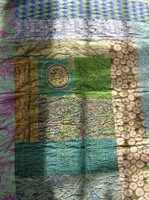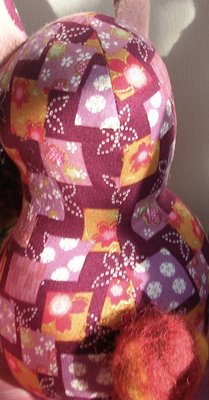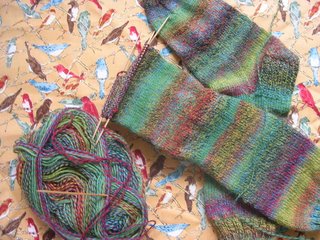12 July 2006
hiatus
ann
 a tea cosy for my Bodum Assam teapot inspired by No Roses for Harry
a tea cosy for my Bodum Assam teapot inspired by No Roses for Harry with the collar folded down (don't click on the photo to enlarge if you don't want to see who got the roses)
with the collar folded down (don't click on the photo to enlarge if you don't want to see who got the roses)My friend Ann Hahn Buechner dreamed up and knit this rosy cosy (in Nature Wool, I think). It definitely gets days going in the right direction. She starts these in the round from the top, splits the knitting to back and forth down the back and picks up stitches on one side of the split for a clever flap that goes through the handle and attaches to the other side with a velcro dot.
11 July 2006
annatto
 the Kokopelli dyed with birch/cherry/cochineal
the Kokopelli dyed with birch/cherry/cochineal the same hank over-dyed with annatto seeds
the same hank over-dyed with annatto seedsI followed Jenny Dean's directions in Wild Color and simmered an ounce of annatto seeds in water for an hour. I cooled the brew off with more water and then added the skein of almost dry yarn. Not wetting out the fiber before adding it to the dye bath means the dye doesn't penetrate the yarn as quickly or evenly so more of the pigment settles on the surface and the final color is more uneven--that's my theory, anyway. I brought the mixture to a simmer and let it stay there for ten minutes before turning off the heat, covering the pot and letting the yarn steep for about 36 hours until I thought of it again. I knew from Wild Color and other sources on natural dyeing that the longer the yarn sits in the bath the more pigment it will absorb, but I was still surprised to see that the bath was almost clear when I lifted out this skein. That was good because I had a lot less rinsing to do and all the water I've been using (wasting) to rinse yarn has bothered me. I'll make a greater effort from now on to use less dyestuff and let yarns sit in the dyepot longer. I'll get the color I want and not use as much water. I'm not getting the color I want from my camera, though. There's a lot more depth and variation in the yarns than these photos show.
10 July 2006
plum
08 July 2006
bugged

a ball of Louet Pearl dyed with cherry and birch bark, but mostly by cochineal
Here is the skein of white yarn that went into the dyepot where I simmered and then steeped birch and cherry bark (taken from the ground around the trees in a local arboretum after a storm). After an hour of processing, the yarn had only turned a pretty, light tea color from all the tannic acid in the bark, but no trace of pink that the birch and cherry palettes from Jenny Dean's Wild Color indicated. I can only guess why the pink didn't come out: the bark was waterlogged when I harvested it so I judged the proportion of bark to fiber incorrectly; or maybe the birch wasn't a species that produces color. I didn't want tea-stained yarn, so I added a teaspoon of ground cochineal to the bath. The combination of the tea stain and fuschia produced exactly what I wanted in the alpaca (picture to come) and in this merino, but the Kokopelli is too bright. Once a fiber is mordanted, however, you can throw it into the dyepot again just after wetting it out, so that skein will go in the next time I use logwood or maybe if I try indigo dyeing some time soon.
07 July 2006
cliffhanger

three hanks of yarn being wetted out for dyeing
MATERIALS: The caramel yarn is alpaca from Henry's Attic, the bulky natural skein is Fiesta Kokopelli and the white yarn is Louet Pearl. They're now in the dyebath and will be dry and ready to show their colors in a few days.
05 July 2006
margie

a baby quilt
My sister Margie made this quilt for Elio by machine piecing the panels and hand tying it with a hundred little knots in yellow embroidery floss. I tried in vain to emulate her style with a similar baby quilt in shades of green, but the composition didn't come together as Margie's does. Part of what makes her quilt so wonderful is that most of the prints read as solids from a distance. Margie's work is always meticulous, but lively and very much her own.

Here's my feeble copy. I'm still in the beginner quilter's stage of just wanting to find a place for my favorite prints.
04 July 2006
independence
03 July 2006
fivers

five wee wonderfuls bunnies

closeup of the felted wool ball tail
MATERIALS: Marcus Brothers woven wool/poly felt, various asian-themed cotton prints, roving for the tails, DMC perle cotton, beads and fabric scraps for front panel decoration, poly stuffing
TOOLS: I used a sewing machine to piece the body and ears, but it could all be done by hand.
PATTERN: Hillary Lang's excellent free pattern available at her weewonderfuls.com site
NOTES: I do wish I had followed Hillary's advice to stuff the bottom of the figures with weighted stuffing, but I'll be making more of these as the mood strikes; these five came together in five consecutive mornings. Choosing fabrics to go with the felt and then picking out motifs from the fabric to decorate the front panels kept me going and going...and going. I like the woven boiled wool better than regular felt for this project because woven fabric will take the stress of firm stuffing better.
01 July 2006
beeswax


bunny and the daffodil my son Bruno made for me for Mother's Day
MATERIAL: colored beeswax from achildsdream.com
TOOLS: hands and scissors and a little roller or dowel for cutting petals, though I think these were done by flattening and pinching
NOTES: The wax often needs warming up before it can be shaped. We like this rhyme to say while we hold the wax and wait: "Warm hands, warm, the farmer's gone to plow. If you want to warm your hands, warm your hands now."




